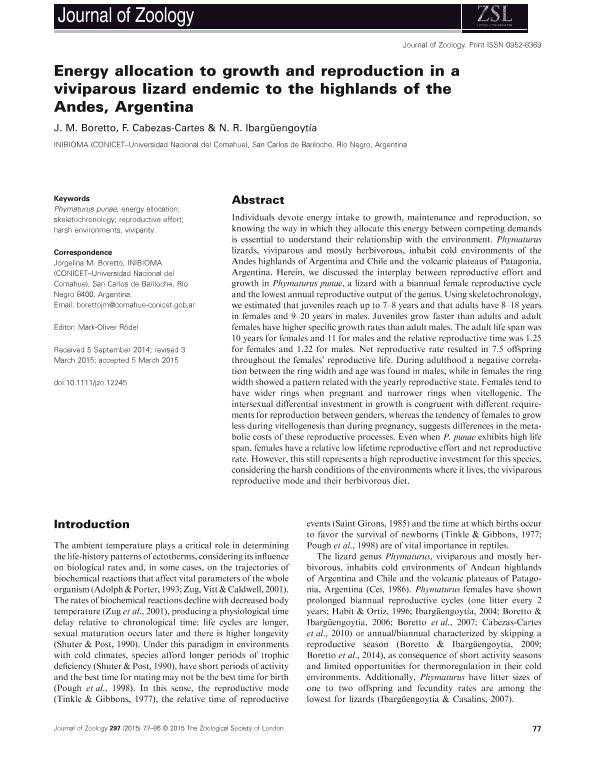Artículo
Energy allocation to growth and reproduction in a viviparous lizard endemic to the highlands of the Andes, Argentina
Fecha de publicación:
09/2015
Editorial:
Wiley
Revista:
Journal Of Zoology
ISSN:
0952-8369
e-ISSN:
1469-7998
Idioma:
Inglés
Tipo de recurso:
Artículo publicado
Clasificación temática:
Resumen
Individuals devote energy intake to growth, maintenance and reproduction, so knowing the way in which they allocate this energy between competing demands is essential to understand their relationship with the environment. Phymaturus lizards, viviparous and mostly herbivorous, inhabit cold environments of the Andes highlands of Argentina and Chile and the volcanic plateaus of Patagonia, Argentina. Herein, we discussed the interplay between reproductive effort and growth in Phymaturus punae, a lizard with a biannual female reproductive cycle and the lowest annual reproductive output of the genus. Using skeletochronology, we estimated that juveniles reach up to 7–8 years and that adults have 8–18 years in females and 9–20 years in males. Juveniles grow faster than adults and adult females have higher specific growth rates than adult males. The adult life span was 10 years for females and 11 for males and the relative reproductive time was 1.25 for females and 1.22 for males. Net reproductive rate resulted in 7.5 offspring throughout the females' reproductive life. During adulthood a negative correlation between the ring width and age was found in males, while in females the ring width showed a pattern related with the yearly reproductive state. Females tend to have wider rings when pregnant and narrower rings when vitellogenic. The intersexual differential investment in growth is congruent with different requirements for reproduction between genders, whereas the tendency of females to grow less during vitellogenesis than during pregnancy, suggests differences in the metabolic costs of these reproductive processes. Even when P. punae exhibits high life span, females have a relative low lifetime reproductive effort and net reproductive rate. However, this still represents a high reproductive investment for this species, considering the harsh conditions of the environments where it lives, the viviparous reproductive mode and their herbivorous diet.
Archivos asociados
Licencia
Identificadores
Colecciones
Articulos(INIBIOMA)
Articulos de INST. DE INVEST.EN BIODIVERSIDAD Y MEDIOAMBIENTE
Articulos de INST. DE INVEST.EN BIODIVERSIDAD Y MEDIOAMBIENTE
Citación
Boretto, Jorgelina Mariela; Cabezas, Facundo; Ibarguengoytía, Nora; Energy allocation to growth and reproduction in a viviparous lizard endemic to the highlands of the Andes, Argentina; Wiley; Journal Of Zoology; 297; 1; 9-2015; 77-86
Compartir
Altmétricas




